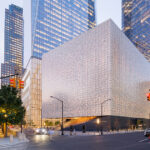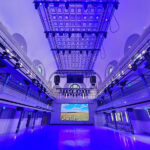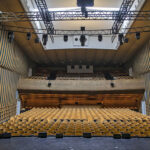For a number of years, the name Oaks Christian has evoked exclamations from sports fans across Southern California and beyond. That will happen when your teams dominate the local sports scene, your starting quarterback goes to Notre Dame and your football team wins the California State Championship game.
Yet, last August, the name Oaks Christian was uttered in awe by locals who had just seen the all-new 30,000-square-foot Bedrosian Pavilion that includes one of the most technologically advanced performing arts centers and media production facilities in the area. Sports fans were also pleased because the performing arts center doubles as a gymnasium that will be used for the school’s basketball and volleyball teams. The fact that these two venues are housed in the same two-story building on a 15,000-square-foot plot was just as amazing.
Pulling Double Duty
The Bedrosian Pavilion was opened after two years of thought, design and construction, reports Oaks Christian Vice President of Business Operations and CFO Paul Oberhaus. “We had the need for some gym space, and we always had the dream of building a performing arts center,” he says. “We started thinking about finding a way of combining them without sacrificing in either area, because it was going to be very expensive to build just a stand-alone performing arts center. So, we came up with this concept of making it multipurpose, but with really high-end performing arts facilities and not compromising.”

Not compromising indeed, considering the two-story facility boasts a stunning assortment of hardware and software on the second floor to make any live performance come off without a technical hitch. The first floor includes classrooms dedicated to performing arts and theatre technology applications, including dance, choir and band rooms, a black box/green room, digital piano music lab and a media studio stocked with Digidesign Pro Tools and Apple Final Cut Pro.
The center was designed by the architectural firm NTD Stichler Architects and built by Matt Construction. Kip Kibler of Kip Kibler Construction Management Services was brought in during the facility’s preconstruction to manage the performing arts side of the operation. In turn, Kibler brought in LA ProPoint, a design, engineering, fabrication and installation provider. The Ruzika Company served as the theatre consultant.
Paying for State of the Art
According to Kibler, what makes the Bedrosian Pavilion project unique is that the team was charged with taking a gymnasium space and turning it into a theatre. “It was pretty unusual,” she allows. “I mirrored a lot of [the Bedrosian] after REDCAT, the Roy and Edna Disney Theater at the Walt Disney Concert Hall. It’s a teaching theatre [at Cal Arts] as well.”
Harvey Sweet, LA ProPoint’s vice president of sales, adds: “[The school’s administration] made the performance part of it as important and, in some cases, more important than the athletic portion of it.”
LA ProPoint President Mark Riddlesperger says, “Because a lot of the parents are entertainment industry folks who have a fairly decent knowledge of what a professional operating theatre looks like and how it should perform, they were very interested and concerned about how they felt that the money was being spent. They didn’t want a general, run-of-the-mill high school auditorium. They wanted something that was state-of-the-art.”
That helped, he adds, when it came time to working with the budget. “So many times, the budgets that we are handed or that we are expected to bid to are unrealistic,” reports Riddlesperger, “but there is an intense amount of pressure to deliver anyway. These folks were very realistic and under-standing about what things cost.” The entire $16 million budget was funded by donations, including a substantial gift from Oaks Christian board member John Bedrosian and a number of donors who gave $1 million or more.
The Gear
One of the first steps the team took to differentiate the gymnasium from the theatre was installing curtains down the sidewalls and adding wood paneling to the proscenium wall. The curtains measure 24 feet high by 92 feet wide, weighing 500 pounds a piece, and are moved via motorized controls. In addition to framing the room, these curtains help with the room’s booming acoustics.
On the lighting side, the LA ProPoint team worked within and then tweaked the initial design provided by The Ruzika Company. “This is a theatre lighting system,” explains Sweet. “It isn’t a band-aided multipurpose room system. It’s a theatre system with a couple hundred theatrical lighting circuits in it, a full complement of house lighting controls, as well as work light circuits. They have the opportunity for lighting from all of the traditional locations that one would in a theatre, and they have a good line of sight control position above and at the rear of the seating area.”
Much of the lighting was placed on six ceiling-suspended 8-foot by 8-foot tension grids high above the floor, so as not to interfere when an athletic event was taking place.
Staging Solutions, Riddlesperger says, came via “14 on-stage motorized hoists, and five of those are stage electrics hoists. One of the interesting challenges was mating the Genlyte Intelligent Raceway Dimming with the DeSisti hoist system design. Their batten design is a complex structure to provide sufficient support on the four lift lines they provide, and we had to figure out a way to incorporate the Genlyte to complement and work with the DeSisti system.”
An answer came while working with Genlyte, Desisti and the team from Ruzika. “We added the Genlyte Intelligent Raceway to the bottom of the DeSisti batten,” he reports. The DeSisti system is built with their proprietary raceway, which is basically a wire trough, supporting a pipe batten. When we connected the Genlyte Intelligent Dimming to their batten and then added a batten beneath that, it grew in height by about 15 inches. It’s a lot of stuff, but it does the job, and it achieves the economy of putting the dimmers on the batons as opposed to having a rack and then all that copper going to the dimmers.”
In addition, the venue boasts 244 theatrical lighting circuits, including house light circuits and work lights. The dimming system uses IGBT dimmers that enable a quieter transfer of energy and minimize the amount of copper needed to power the system. A pair of wall-mounted lighting control stations allows non-techies the ability to select one of eight possible lighting looks to illuminate the stage as necessary.
Bidding Bye-Bye to Copper
David Alexander, who serves as Oak Christian’s technical director/facility manager, points out there is very little copper going from the stage to the booth. “It’s all Ethernet,” he reports. “They decided to not go with much wireless because they could pull cable when they were designing the building from the ground up. The wireless snakes would have been a little overkill for this venue, since we were able to set up an infrastructure.”
Alexander came to the school from Pacific Arts Plaza, where he also oversaw the opening of a brand new facility. “The reason I took this opportunity was not just the excitement of a new venue, although that had a lot to do with it,” he says. “There is a lot of technology here that blows away anything we had at Pacific Arts Plaza — the motorized electrics, brand new dimmer systems going on, a new control system, all digital audio and video system. But, the biggest thing that drew me here was the people.”
He is looking forward to kicking off a theatrical technology program to educate the schools interested, as well as helping with the school’s ongoing production schedule that includes a presentation of The Diary of Anne Frank in November, Godspell this spring and the weekly chapel sessions that take place in the facility.
From his seat, the Bedrosian’s “crown jewel” is its flexibility. Video signals can be split to go to the front of house position or to the media control room on the first floor to be edited in Final Cut Pro and then sent back to the three HD-capable projectors in the main room. “We’re two steps away from being a broadcast studio,” he says proudly.
In addition to all the things happening to contribute to the performance on stage, the Oaks Christian team felt it was important to ensure the audience’s comfort. So, a flexible-seating arrangement was designed that includes carpeted risers that students can sit or stand on during chapel, but during a more formal event, 400 comfortable theatre-style chairs are placed on the riser and on the floor to accommodate the crowd.
While he’s still working on the logistics, Alexander points out that it will typically take about three hours to go from athletic to performing arts setup. “But once everything is dialed in, it’s just a matter of how long it takes to plug in the microphones,” he says of the facility’s technical make-up. “The infrastructure is already there and it’s all digital. This place blows the doors off any high school theatre that I’ve ever seen.”


